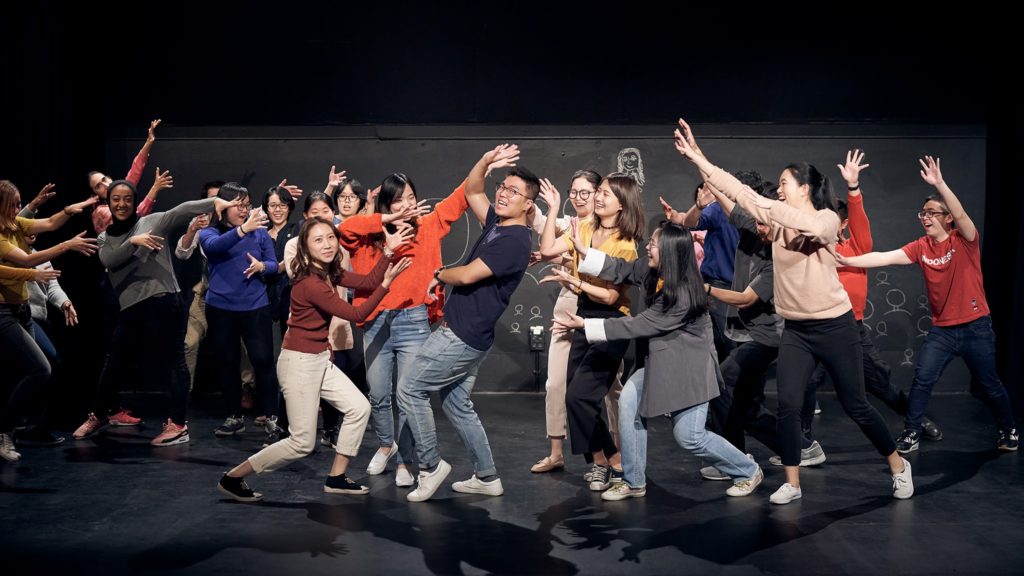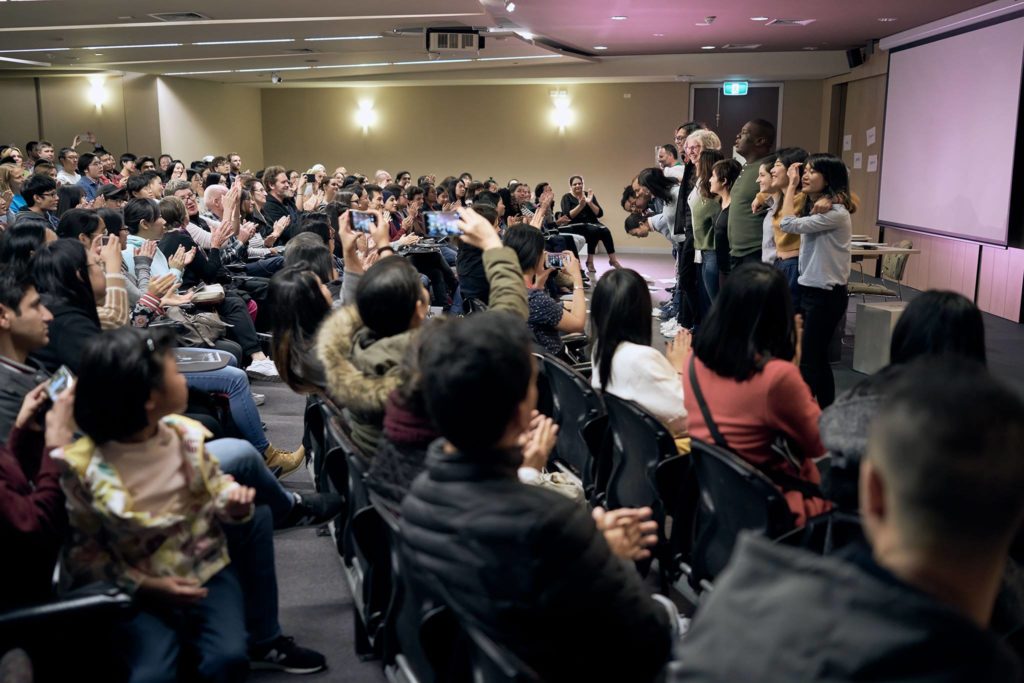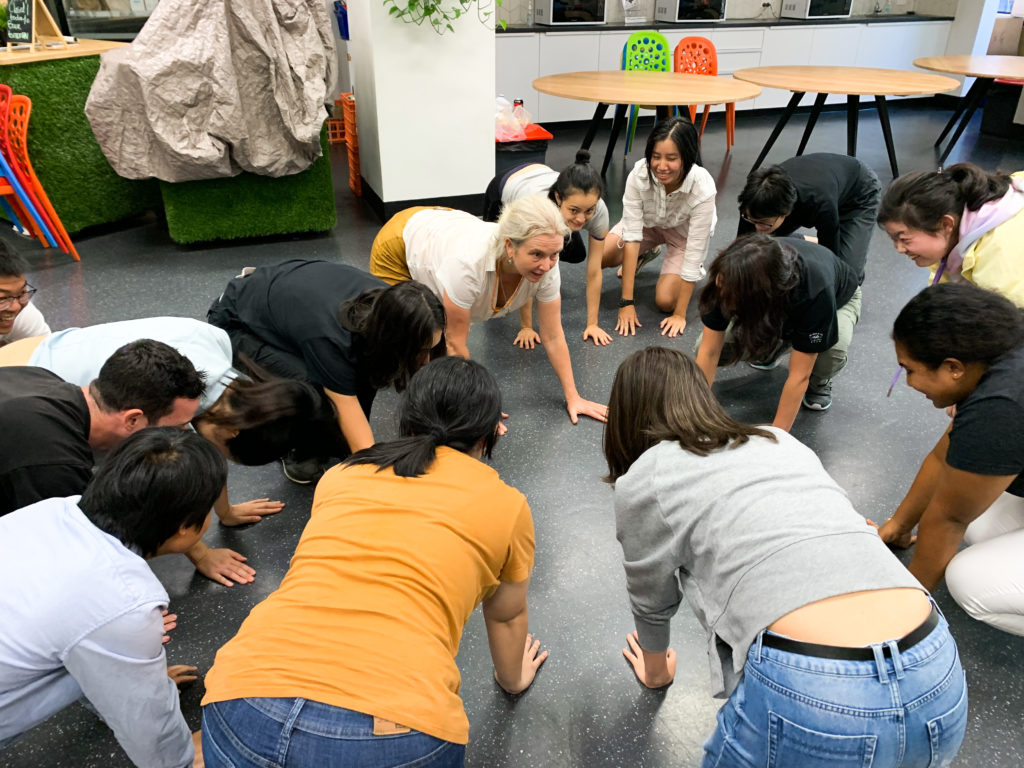Let the show begin!
“Now we present to you ‘If I Tell You The Truth’,” announced Catherine Simmonds, our artistic director. This was the start of our big 2019 performance in RMIT Kaleide Theatre. It was a lot of work, commitment, fun, opening up to each other, etc. I was part of the student performers group and a volunteer in the project. Most of us were not trained actors but we are ‘actors’ of our own true story. Many people ask me how and why students joined the Be You – Be Scene (BYBS) project. I think that this journey is different for each one of us and I can only tell you about mine. I have to warn you that this reflection is a long one.
BYBS ‘If I Tell You The Truth’ Performance (photo credit: Andrew Coulter)

Before BYBS began, there was another project called Act Of Translation Reaches Out. It was a similar project to BYBS. At that time (March 2018), I was volunteering as a graphic designer in AFIS (Australian Federation of International Students) and was assigned to be responsible for some of the promotional materials for the final performance of Act Of Translation Reaches Out – ‘She’ll Be Right’. During my time in AFIS, I have only been involved in shorter-term projects like the AFIS Amazing Race. Act Of Translation (AoT) Reaches Out was my first bigger project. I was encouraged to watch the documentary they filmed to understand what the project was about. I was amazed by how powerful the messages in the documentary were (and still are). The truth about international students’ experience in Melbourne which was at that time ranked as the most liveable city in the world. The struggles that students faced when coming here, how being in Australia was not only to get a degree but discover a new side of themselves too. I will not go in too much in details about what the documentary is about as I think it is better if you watch it yourself.
Weeks passed by and it was the day of the ‘She’ll Be Right’ performance at Victoria University. The posters, flyers, booklets were ready, printed and displayed around the venue. I was among the audience, waiting for the crew to let us enter the room where the performance would happen. When we were allowed to enter and take seats, it immediately became obvious that there would not have enough chairs for every person. Some people had to sit and even stand near the walls. The performance began and scenes after scenes everyone in the room kept being surprised, emotional and relatable to the students’ stories. At the end of the performance, we were all clapping and giving a standing ovation. Even though I watched the documentary before, I quickly realised that it is not the same feeling that you get when you watch the performance physically. The limitations of technology and digital media…
‘She’ll Be Right’ Performance (photo credit: Andrew Coulter)

A few weeks after the performance, I was contacted by Feifei Liao (our project manager for BYBS) who informed me that they were going to start the next project ‘Be You – Be Scene (Stories at the heart of change)’ in August 2018 (we were in May 2018 and maybe some of you might think that we were planning very early. I suppose that we were all eager to start the project!) and she wanted me to be on the volunteer team. I was honoured and excited! Why? Because I would be there since the start of the project and not get involved only at the end of it (like what happened for AoT Reaches Out). Since ISANA was the lead organisation of the BYBS Project, I was going to be an ISANA volunteer and not AFIS volunteer. This was also how I began my journey with ISANA (Vic/Tas).
Between May and August, I was introduced to the new volunteer team for BYBS, had a meeting/interview with Mano Guy to get to know each other and learn about ISANA. I was still part of AFIS and designed a few posters for some of the events AFIS was organising. As we were approaching the first BYBS workshops, the BYBS were communicating more and more and getting the first few drafts of the marketing materials ready and distributed. The first workshop happened, then the second, the third,… Every week the posters and banners had to be updated – change the venue, change the dates, time, theme we were exploring on that week. I started to have a routine. Get information from Feifei and the content writers, update the content on the flyer, send a draft to the team, get feedback, make changes, upload the final version on the drive, tell the team that the flyers were ready, post on social media (I was also helping for some of the social media channels too. Quite funny, considering I am not that active on my own personal social media channels.) and repeat the following week.
Compare to my experience in AFIS, I felt that with the BYBS team I could connect more. I think the reason was that we were a smaller team and met with each other physically more often. It was easier to know what was happening in the whole process and not just the things you were responsible for. For example, I was mainly involved in the marketing team but I knew what was happening in the event team because of these regular meetings. We did have a few minor struggles at the start as all of us were learning new skills and how to collaborate with people from different backgrounds.
We explored quite a number of messaging apps and how to share documents and updates on our task. Some of these apps did not work for our team. Slack at the beginning was a struggle. All of us never used slack, except our project manager. Us, volunteers were used to Whatsapp, Messenger, Wechat, Snapchat. Slack was a bit complex to use and most of us did not know that the instant notification was not the default settings. We were late at replying messages because of that. Other challenges we faced were volunteers coming and leaving, making sure that everybody was on the same page when it comes to responsibilities and expectations. As we moved forward in the project, we were able to find a more stable way of collaborating. We still faced some unexpected situations, but we were able to cope with them. Some of us started to get more roles and tasks as well (which is expected as the core volunteer group was quite small).
Now some of you might wonder about the performance part and since when I started to perform. In the BYBS project, behind every single performance, there were lots of workshops and individual consultations. These ‘behind the scene’ elements are often not known or forgotten by the audience. But they are essential as the workshops and individual consultations were the platforms where students could explore their stories, develop their skills, be vulnerable, learn from each other and build relationships. In my case, I only started to regularly attend workshops in 2019 because of my university schedule, work placement and I was also volunteering in three different organisations at that time. I knew that I had to let go some of these before I commit to performing in BYBS. So the best option that I could think of is to wait till the end of 2018 to decide whether or not I wanted to be a performer and not just a volunteer. Catherine already asked me a few times and if you meet her, it is hard to say no (she is not forcing you to perform but there this ‘je ne sais quoi’ that makes you want to be part of it xD).
When January 2019 came, I decided to stop volunteering at AFIS. (I had a one-year commitment with AFIS that ended in December 2018.) So when the workshops started again after the short holiday break, I began attending them (almost) every Wednesday. At the beginning it was a bit weird doing the different exercises we were asked to do but gradually it began more natural. I got to know the other students more during these workshops. There are some things that I shared with the group that few have heard about. I also feel very honoured to be able to listen to other students’ stories as well. There was trust in the group that was developed. We knew that we could trust each other, not to gossip or judge each other.
‘BYBS Workshops (photo credit: Thi Phuong Anh Ngo (Ana María))

Before the ‘If I Tell You The Truth’ performance in May 2019, we had other performances and forums. Unlike the ‘If I Tell You The Truth’ performance that explored all the topics (employability, accommodation, mental health, cultural diversity and LGBTQI), these other performances/forums were focusing on one or two particular topics. My story that I performed fits in the cultural diversity topic so I was performing only in cultural diversity performance/forums. Even though my script does not really change, it is always a new experience to perform it because the audience, environment and group of performers change. Speaking of group of performers changing, what I meant is that not everyone is available to do all performances. This is because we are students from different courses, universities and have other commitments outside the BYBS Project and it is really hard to attend all performances that happen in different locations (we had a few in the regional areas!), days and time. Scenes had to be reformatted depending on who could perform for what event. But for the big performance at Kaleide Theatre, all performers were committed to making it.
As we were approaching the Kaleide Theatre performance day, we were having more and more rehearsals. The script kept on being updated as we were practicing, moving certain scenes before others, confirming who needs to be in which group scenes. We even created a short dance routine for the ending with the help of Yumi who is a professional dancer and choreographer (Thanks Yumi!). When the Kaleide theatre was not available for our rehearsals (there were other groups who were rehearsing there as well), we were meeting somewhere else in RMIT University. The volunteer team also had to double, triple their effort: confirming catering, planning the schedule of the event, promoting the event every day, looking for extra volunteers since most of our core volunteer team members were performing too. For my role as the graphic designer, I had to design new materials just for the performance: new posters, a booklet that will be printed, a digital version of the booklet, some of the social media posts, flyers for evaluation and schedule of the event and the media wall. Fortunately, I had our people in the team to help me.
The big show was a huge success. The theatre was so filled that some people had to sit on the stairs. By the end of the performance, everyone was emotional. For me personally, I was sad that BYBS was reaching to the end, relieved that I will be able to rest, proud of our group achievements and happy to be able to share these moments with amazing people. We still had some smaller performances and forums after the ‘If I Tell You The Truth’ event but we no longer had weekly workshops since the BYBS project relied on a grant that ended after the show. Now (September 2019) we are still in touch with each other (mostly on social media). It is not exactly the same thing as seeing each other every week. Some of us are working together to set up an independent organisation (Story IS Connection) to make the project start again .That was a long reflection and still this is just a summary of my journey in BYBS. To conclude this reflection, let me just say that storytelling and the arts are very powerful tools to raise awareness, empathy and make us realise that despite all our differences (beliefs, origins, status, gender, etc.), we are all humans.
I am looking forward to this new chapter – Story IS Connection
(SISC)!
Thank you for your time!
Cheers,
Juliet